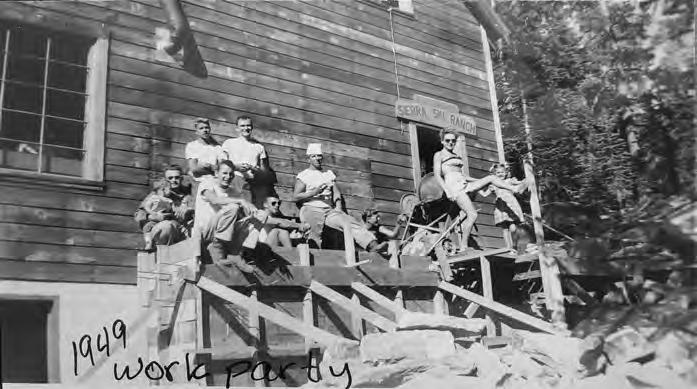
6 minute read
Seasons of Sierra At Tahoe
by Christopher Couper
built an entire program around it and makes sure that every employee, at every level, is trained that way and operates in that manner. And the goal is to encourage customers, even first-time visitors, to join in too. Read on to find out how this tradition began.
Advertisement
The tradition began when Ray Barrett attended Sacramento City College, where he joined the ski club. The ski club is where Ray met his future wife, Jenis. Most of the frequent weekend trips into the Sierra Nevada were to the Donner Summit area, and occasionally other areas. Ray felt that it was a shame that there were not more options up on Echo Summit, so in the Spring of 1945 he began inquiring with the US Forest Service about what would be required to open a small ski area near the summit. Encouraged by their response, he located a nice area to the south of Mount Ralston and the American River. Ray enlisted the help of his brother Floyd, who had just been discharged from the Navy, and Floyd’s new wife, Audrey. Accompanied by Ray, the new couple drove cross country from West Virginia to help. Together they began laying out locations for ski continued on page 11 runs and a coffee shop.
Putting in a ski area requires much more than thought. The Barretts were short on funds for such an adventure, but Ray did have many friends and classmates. So the model that was created in those early days of “Sierra” was “work a bit, play a bit”. Essentially, everyone that wanted to be a part of the resort traded work time for play time. Work might be felling trees, building and maintaining lifts, working in the coffee shop, constructing the lodge or providing ski patrol services. It was hard to differentiate staff from customers because many were both. When you came to the early Sierra Ski Ranch, you were immersed in a gigantic extended family experience. This elevated the ski area’s reputation and the family vibe was one of the reasons the resort became so popular, even though it was only open on weekends and holidays.
One summit area local, Vern Sprock, was so enthralled that he started to work part time for the Barretts and even convinced them that he could keep the resort operating on the weekdays too. With the technology boom after WWII, the Barretts were working full time at McClellan Field. They also had young children and found themselves with little time to operate a ski resort. So, in December of 1953, the Barretts sold Sierra Ski Ranch to Vern’s new in-laws, and Vern and his new wife, Bobbie, operated the resort.
The Sprocks continued with the resort’s extended family model. To extend the operations, the Sprocks reached out into the local community. Word soon got out and more and more people from both the west slope and Tahoe Basin came to the little roadside ski area to see how they could be a part of the experience. The extended family was growing, and now included the Sprock’s own children, Kathy and Peter. Winter resorts have a unique staffing issue; they generally operate in the summer “off season” with a skeleton crew doing maintenance and improvements. But then, with the onset of winter, staffing needs to escalate rapidly. This dynamic makes it difficult to build and run a winter resort business. But the experience at “Sierra” was so positive, most of the employees wanted to come back each season. The Sprocks were excited about that arrangement. The idea of permanent part time became part of the vernacular and continues to this day at “Sierra”.
The resort grew, moving upslope to its current location in 1968. It prospered because employees, even though part time, felt as if they were part of the Sprock family, that they were important and critically valued. Parking lot attendants, bus boys clearing tables, ski instructors helping you learn to ski and lift operators helping you get on the lift, all gave the impression you were skiing at “their ski resort”. This feeling expanded and continued on page 16
“Women of Influence: Women Making History in El Dorado County” was an exhibit at the El Dorado County Historical Museum that told the stories of women who lived, worked, and contributed to the rich history of El Dorado County. Artifacts and photographs in the Museum’s collection guided the research, allowing us to uncover stories about these women who were part of the county’s history. Sometimes history of a particular person or region is equated to constructing a quilt, where many bits and pieces eventually become a whole.
Sarah Ingham (1826-1898) Quilter

Sarah and her husband moved to Placerville in the 1850s. Sarah’s husband, George Ingham became a County Judge and later Justice of the California Supreme Court. Their daughter Albina, known as Bine, learned the newspaper business at the Mountain Democrat, and was eventually named publisher, a position she held until her death. (Bine’s story will be told in another installment!) continued on page 14
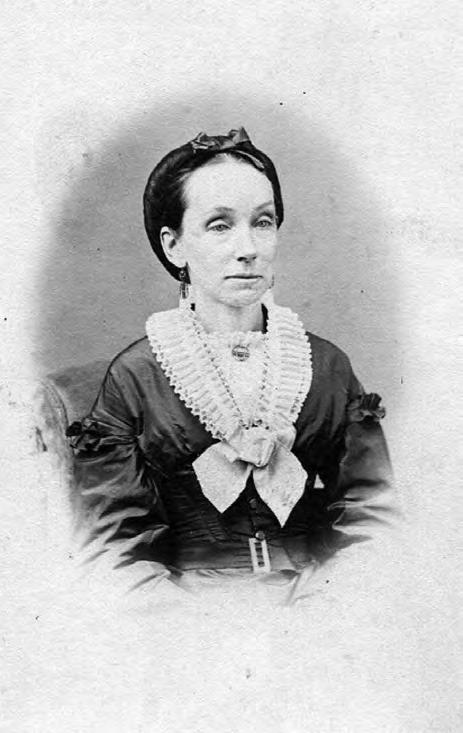
We don’t know very much about Sarah Ingham. However, the beautiful crazy quilt that she created is an example of an artifact that can help us better understand the times she lived in. The quilt is displayed on the Museum’s 1878 walnut bed from a home in Indian Diggings. Made from scraps of silks and velvets held together with decorative hand embroidery, crazy quilts were a very popular textile craft of the 1880s and 1890s. Sarah incorporated silk ribbons about local groups and event into the quilt, including this one celebrating the completion of the Placerville & Sacramento Valley Railroad to Placerville in 1888!
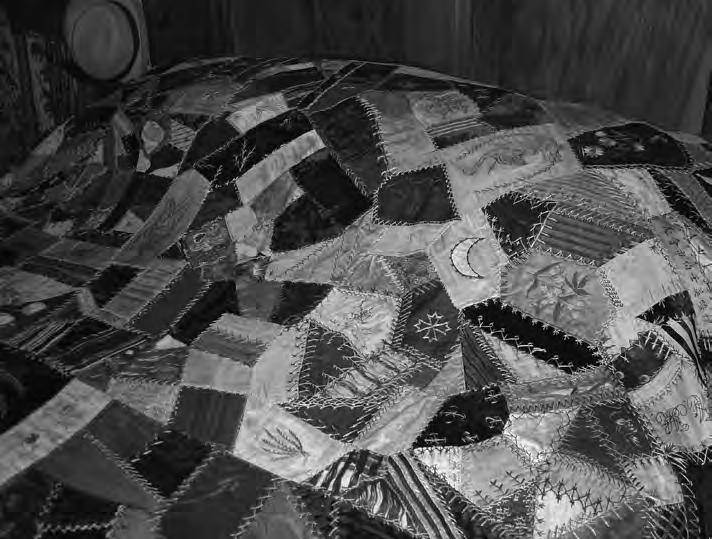
Lucinda Nail lived her whole life in the Somerset and Grizzly Flats area. Her parents owned the toll ford/bridge on the middle fork of the Cosummes River below Somerset. Lucinda married George Nail who was the superintendent of a mine in Grizzly Flat and was drowned at Bucks Bar trying to ford the rising river. Lucinda was expecting her second child at that time. To support herself and her two daughters Lucinda took in work as a seamstress and became a wellknown dressmaker. She owned property and made a good living as a dressmaker raising her two daughters by herself.
Sewing and needlework were important skills for women to know. Treadle sewing machines became available and affordable after the Civil War and most women had basic sewing skills in order to make clothing, quilts, and other household textiles for their families. However, some women such as Lucinda, were able to make a living sewing the complicated and fashionable dresses for women in the community.

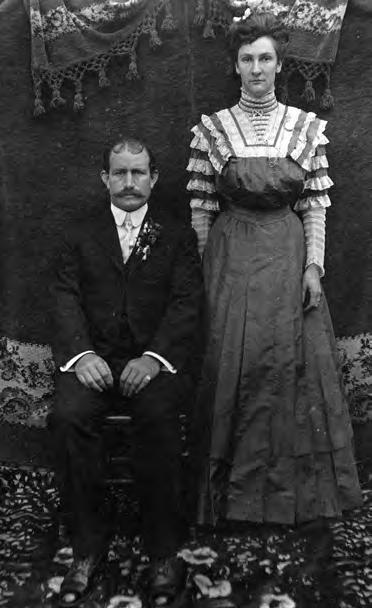
Lucinda pieced and embroidered a Crazy Quilt Pillow on display in the Museum’s Bedroom exhibit. The pillow is hand stitched, made with silks and velvets and has silk embroidery embellishments.
Georgia Nail Leoni was born six months after the death of her father. Her mother, Lucinda Nail, raised Georgia and her sister Hattie alone as a dressmaker in Grizzly Flats. In 1910 Georgia married Stephen Leoni, a dairy cattle rancher in Grizzly Flats. Together, they operated the ranch and drove their cattle seasonally between the Mountain Meadow Ranch in Grizzly Flats and Clay Station in the western part of the county for winter grazing. Stephen died in 1927 and Georgia continued to live at the Mountain Meadow Ranch (now known as Leoni Meadows) until 1941. She walked the three miles to Grizzly Flats to get her mail, and when she needed to go to Placerville, she drove an automobile. However, she only knew how to put the car into second gear, so she drove all the way to Placerville in second!
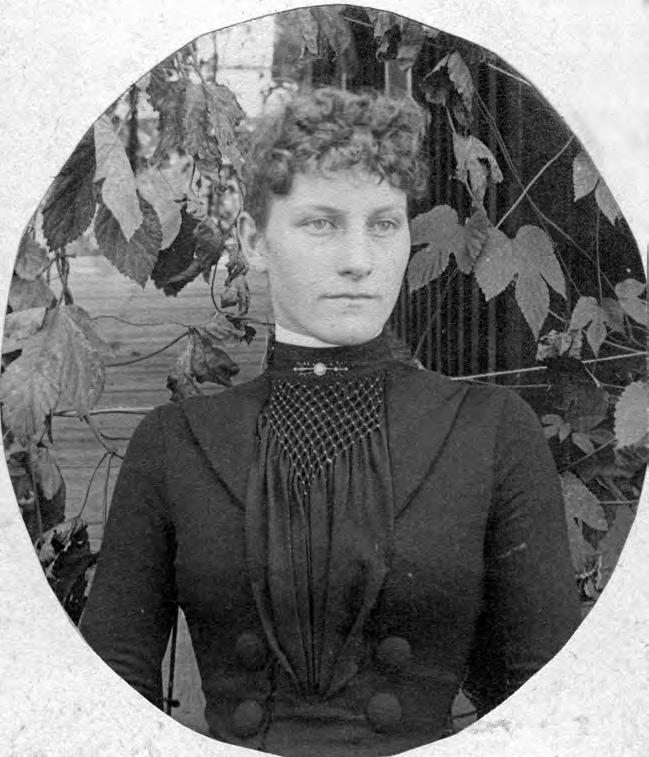
Georgia did all her own chores like chopping wood, hunting for food, growing and continued on page 15 preserving fruits, vegetables and meats, and she helped with the dairy animals, making the butter that they provided to restaurants and the Caldor logging camps. Georgia used an outdoor kitchen as much as possible because the heat was so extreme in the kitchen. The story is that her staff in the kitchen kept fainting from the heat so she had a fainting couch placed there!
After 1941, Georgia moved to her mother’s home in Grizzly Flats. Known by many as “Georgie” she was an active member of the community. Although she never had children of her own, she loved children and was member of the local school board. She and Stephen were very hospitable people and hosted many parties and events.
Mary Cory is the curator of the El Dorado County Museum and has a tangible passion for history and all things El Dorado County.








